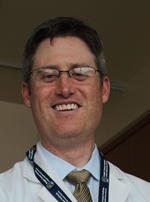
By St. Baldrick’s infrastructure grant recipient Brandon Hayes-Lattin, M.D.
Each year, about 70,000 adolescents and young adults (ages 15-39) are diagnosed with cancer in the United States. Despite the increase of childhood cancer survival rates in the last two decades, adolescent and young adult (AYA) patients have had minimal improvement in cure rates. Contributing to this statistic is the AYA population’s low numbers of participation in clinical research trials.
Clinical trials are an essential part of treatment for cancer patients of all ages because they provide the most innovative drugs and therapies. According to the National Comprehensive Cancer Network (NCCN), only about 10 percent of 15 to 19-year-old patients and 1 to 2 percent of 20 to 39-year-old patients enroll in clinical trials, which can directly affect their outcome.
AYA patients have difficulty enrolling in these trials for several reasons. Sometimes the clinical trials that they’re eligible for are not open at their institution or their physicians are not aware of them. Often, AYA patients get admitted to adult hospitals, where they might not have clinical trials for their age group or type of childhood cancer. The challenge of getting AYA patients to be aware of these trials and enroll in them requires a whole new level of infrastructure and support.
St. Baldrick’s funding is helping our institution, Oregon Health & Science University (OHSU), achieve these requirements by supporting a clinical research assistant (CRA) who will have the ability to cross both worlds: the pediatric hospital and our adult hospital. The CRA will ensure those clinical trials can include AYA patients and provide psychosocial status and support for them.
I’ve met many young adults who were never offered a clinical trial experience. I had a 20-year-old patient whose diagnosis was delayed for several months at another hospital before he had a biopsy to prove that his problem was cancer. Once he was diagnosed, he received standard therapy, but wasn’t informed about clinical trials or fertility risks with chemotherapy. This became a significant issue later in his life when he wanted to have kids. When his cancer relapsed, he was referred to our institution, where I met him for a bone marrow transplant.
Many years after the transplant, he’s done very well and continues to be a big advocate of our AYA program. He often does speeches or media events telling his story on behalf of AYAs with cancer because of the issues he once faced: delay in diagnosis, lack of knowledge of clinical trials, and lack of fertility information.

As a young adult cancer survivor, it’s been my passion to help adolescent and young adult patients who don’t often have the best resources in understanding cancer diagnosis, treatment, and recovery. I’ve been privileged to help establish a program at OHSU that offers various services, such as fertility preservation, psychosocial programming, and financial support specific to AYA cancer patients. Now, our program will include the extra research support from a CRA to increase participation of young adults in clinical trials, their best hope for a cure.
For more on AYA, read the experience of 2012 Ambassador Kid Sarah as a college student with cancer.

 SBF
Tweets »
SBF
Tweets »